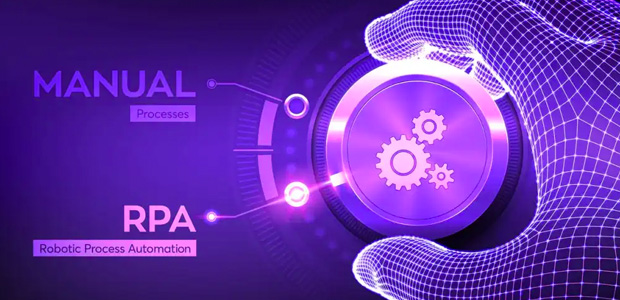Robotic Process Automation (RPA) in Medical Billing
What Exactly is Robotic Process Automation?
 When you come across the term “robotic process automation,” you might think it sounds rather futuristic. However, RPA, as it’s often termed, is a technology being deployed more and more in the healthcare industry, including medical billing.
When you come across the term “robotic process automation,” you might think it sounds rather futuristic. However, RPA, as it’s often termed, is a technology being deployed more and more in the healthcare industry, including medical billing.
Robotic process automation (software) consists of tools that partly or fully automate human behaviors that are manual, rule-based and usually tedious. RPA works by imitating the actions of a real human working together with one or more software applications to accomplish tasks such as data entry and process traditional transactions or reply to simple customer service inquiries.
The Value of RPA
Healthcare organizations function in real-time without any slack. Awkward, error-prone assignments slow processes and influence everything from cost structures to compliance to the patient experience. RPA creates proficiencies by automating tasks that enhance the accuracy of information and reporting and allow decisions to be made more swiftly. This transforms to cost savings and, in the end, means that resources can be employed where they are most needed.
What are the Benefits of RPA?
With pressure to cut costs, boost the speed of operations, streamline tasks, improve the efficiency of processes and enrich the patient experience, healthcare providers are positioned to benefit considerably from RPA.
Think of RPA as a virtual associate, a hidden employee that performs mind-numbing tasks to permit your real employees to focus on more essential revenue-generating tasks. As a software solution that acts as a low-priced virtual employee, RPA offers a variety of benefits, including:
- Dependability: Operations can be executed 24/7 as the robots work independently, only needing human involvement when an employee must make a determination to manage the robot’s next move or fix an error discovered by it.
- Compliance: RPA can abide by company compliance regulations and deliver an audit trail record of the work completed.
- Supervise and Schedule Patient Appointments: Appointment scheduling and administration can profit from automation using RPA and other such processes to interrelate with patients. Plus, it’s feasible to schedule, cancel or revise patient appointments as needed.
- Productivity: Since the robot functions consistent with an automated schedule, process cycle times (in this instance, revenue cycle processes) can be achieved at a significant faster speed compared to manual work.
- Uniformity and Accuracy: Designed to execute particular tasks the same way each time, with no variation, RPA gives rise to extreme accuracy and uniformity in task achievement compared to clear-cut human errors such as typos.
- Communications: In healthcare, RPA can be employed to automate communications such as replies to queries on the website, first-line calls to customer service, front-line administrator questions and email blasts to patients, vendors and staff.
(Revenue Cycle) Medical Billing RPA
RPA can be used in nearly every step of the medical billing process to help automate and standardize routine and inefficient tasks. Common areas for the employment of RPA in medical billing are payment posting, electronic health records (EHR) and claims administration.
- Payment Posting
Payment posting is an important part of revenue cycle management and improves cash flow and patient satisfaction if done accurately. Doing so through automation aids in productivity and streamlines the troublesome manual process of posting insurance payments. Electronic remittance advice (ERA) is an electronic version of a paper explanation of benefits (EOB) and encompasses specifics about the amount billed, what’s is paid by the health plan and an explanation of any inconsistencies between the two. By employing ERA, which is intended to work with other medical billing technologies, minus human involvement, payment postings can be automated, leading to quicker account reconciliation, reduced operating costs and greater staff efficiency. - EHR Automation
EHRs were intended to deliver important patient information in digital form and cut administrative tasks. Regrettably, EHR use has been associated with physician burnout. Many physicians are fatigued working with EHRs in as little as 20 minutes, and EHR usability matters often give rise to a boost in mental load and errors, which can bring about patient safety concerns. With the pervasive use of EHRs, many physicians expend more time than ever behind a computer screen in lieu of concentrating on patient care. RPA robots can be used to automatically complete EHR fields and replicate essential information across systems. This lessens the chances of human error and allows physicians to devote more time with patients. - Claims Administration
Not only are inputting, processing and adjusting claims inefficient, but more prone to human error, an everyday reason for claim denials. However, it’s been shown that automated claims processing cuts the quantity of manual work by up to 80 percent. According to a recent McKinsey study, 25% of the insurance industry will be automated by 2025. The well-recognized consulting firm also observed that automation can cut the cost of a claims journey by up to 30%.
Investing in RPA
Investing in robotic processes automation for claims processing aids healthcare organizations by:
- Cutting costs and boosting efficiencies at every point in the process;
- Helping reach goals in expanding patient service excellence and cost-effectiveness;
- Lessening human interaction in routine tasks, e.g., monitoring of services;
- Performing tasks quicker and more efficiently via technological solutions, and
- Allowing them to concentrate on basic tasks that call for specialized experience;
- Offering a clear-cut, detailed claims entry process, which translate into greater control over the process and enhanced visibility for all concerned;
- Cutting the need for reconciliation involvement;
- Lessening manual chores, paper transactions, hard copy filing and telephone interactions.
Summary
At Medwave, our claims management solutions create, send and track claims quickly. We automate processes for high-volume, low-touch claims as well as unusual claims. Just give us a call to discuss how we can help automate your billing procedures so that you stop revenue leakage.
If you don’t want to make the investment in robotic process automation at this time due to low volume? It’s OK, contact us for our non-automation options.

